Aftermath of the 18th September 2011 Sikkim earthquake
By : Indranil Chakraborty, Dr. Saibal Ghosh, Debasish Bhattacharya & Anjan Bora, Engineering Geology Division, Geological Survey of India, Eastern Region, Kolkata
Introduction
According to the Indian Meteorological Department (IMD) 1, a strong earthquake of Magnitude M: 6.8 shook Sikkim and Darjeeling areas of India and adjoining Nepal at 18.11 hours IST on 18th September 2011 with its epicenter (27.7oN, 88.2oE) lying near the Sikkim-Nepal border, about 68 km northwest of Gangtok, Sikkim with the depth of its hypocenter at about 10 km. As per the USGS estimates 2, the epicenter of this strong earthquake (6.9 Mw) lies slightly west of the location shown by IMD. This earthquake was widely felt in Sikkim, West Bengal to Rajasthan in the west and the northeastern states of India, and also in Nepal, Bhutan and Bangladesh. This major earthquake triggered several landslides in the region and a large number of which were studied during a recent post-earthquake fieldtrip (22-29 September 2011) to the Darjeeling-Sikkim Himalayas. The fieldwork was planned within four days’ of the event to the worst-affected areas in Sikkim-Darjeeling Himalayas that are accessible by roads. The aim of this study was to rapidly assess the damage caused by these earthquake induced landslides along with collection of the relevant landslide-related attributes for inventory and further study.
It is also pertinent to mention here that moderate to heavy monsoon rainfall prior to the occurrence of 18th September 2011 earthquake, during and post earthquake event is reported from some areas, which perhaps also contributed to some extent in lowering the shearing strengths of already-loosened (due to earthquake shaking) slope forming mass and ultimately triggered some landslides at selected locations just immediately after the earthquake shock. Due to this reason, it was considered wise to name these landslides as earthquake induced landslides instead of the co-seismic landslides in truest sense. Although, present field observation took due care not to mix up with landslides that are triggered by rainfall prior to 18th September earthquake.
Study area & Seismicity
The study area falls within the Lesser and Higher Himalayan regions with an elevation ranging from 65 m (around Dudhia, Darjeeling District) through 800-1200 m around Ranipul, Mangan, 1400 m around Darjeeling, 1800-2200 m around Gangtok, Pelling, Ravangla to 2800–3200 m around Kyangsla (near Nathula) with elevations increasing gradually from south to north. In the Lesser Himalayas towards south, the slope is gentler and in the undulating stretches, numerous streams and rivulets flow along the depression and finally join with the trunk streams. In the Higher Himalayan terrain, the topography is highly rugged, characterized by steep slopes with prominent gully erosion. The Tista-Rangit water divide is the main north-south water divide within the Sikkim Himalayas. Another north-south water divide is between Lachen Chu & Lachung Chu which starts at about 3000 m and slowly increases up to 6700 m. North of Dikchu, steep ridges on the eastern side are there but of smaller extent as the Tista valley is sub-divided by the water divide between Lachen Chu and Lachung Chu. On the western part long ridges are present – these are Talang Chu and Zemu Chu water divide. Geologically, the mountainous regions of the Darjeeling and Sikkim Himalayas are part of the active Himalayan Fold-Thrust Belt (FTB), which is geologically and structurally complex exposing a number of overturned (towards south) and thrusted sequence of variably metamorphosed pelitic and psammitic rocks over Mesozoic (Gondwanas) and foreland rocks composed of Tertiary (Siwaliks) sediments in the south3.
As per the Seismic Zonation Map of India4 the state of Sikkim comes under Seismic Zone IV – a zone of considerable vulnerability. The nearby region in the further north comes under Zone V and is highly susceptible to moderate to major earthquakes. In this area, most of the previous earthquakes were of shallow focus (< 40 km) and are commonly of 4.5 to 5.5 Magnitudes on the Richter scale. The regional distribution of earthquakes and lineaments/faults in Sikkim and adjoining Darjeeling areas indicates that a number of past moderate (M 5.0 to 5.9) and slight (M 3 to 5) earthquakes5 are clustered around the Tista Lineament trending NW-SE direction. Northern extension of the Tista lineament cuts across the NE-SW trending Kanchanjungha lineament. Another NW-SE trending lineament marked as a fault along the Tista River between Lachen and Chungthang (and further southeast) appears to have been the cause of some high Magnitude earthquakes in the region6.
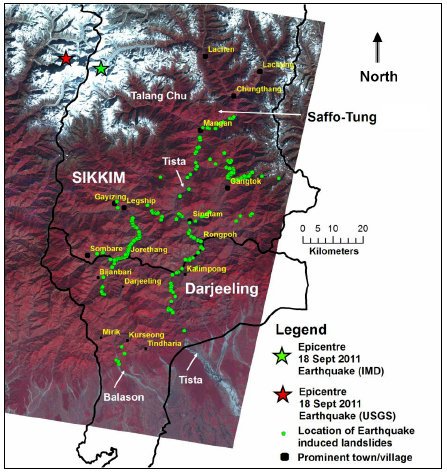
| Fig. 1: Map showing locations of 18 September 2011 Sikkim earthquake induced landslides observed along important road-corridors in Sikkim-Darjeeling Himalayas (in background multi-spectral IRS P-IV Satellite’s LISS III image of 2005 was used). The locations are plotted using Geographic Coordinates in Latitudes/Longitudes using WGS 84 global datum and UTM projection parameters. |
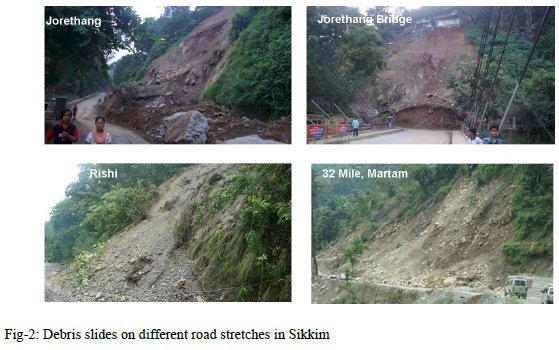
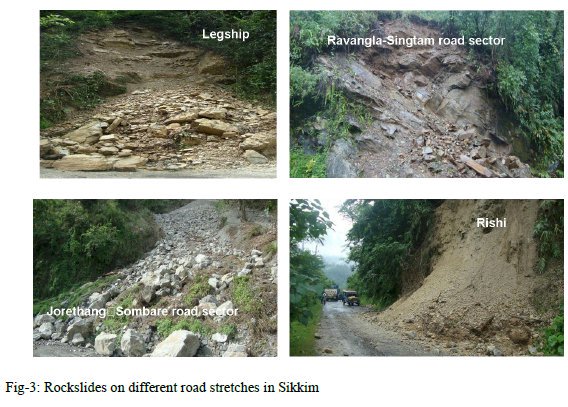
Earthquake induced landslides
Due to the 18th September 2011 Sikkim earthquake (M: 6.8), several “new” and a few “reactivated” landslides have occurred right from the Himalayan foot-hill region (e.g., Dudhia in Kurseong Sub-division, Darjeeling District, West Bengal) up to the higher Himalayan range in the higher reaches of Sikkim-Darjeeling Himalayas. The new landslides that occurred in the lower elevations are mostly concentrated within the terrace deposits of trunk streams such as Tista, Rangit and Balason etc. and within the old colluvial deposits on the lower reaches of slope adjacent to trunk streams (e.g., Jorethang-Rishi-Legship section along the right bank of Rangit river). In the slopes having steep relief, the frequencies of rock/debris fall are more than to slides, whereas field observation clearly indicated that proximal to epicentral region, frequencies of both rock fall and rock slides are much higher than the debris/soil slides and the same are more concentrated towards the crest of steep ridges. Recent field observation of the landslide-related damages further indicated that lithology and geomorphology also played a significant role in causing these earthquake induced landslides. The debris-laden slope which is made of loose unconsolidated material and the slope covered by thin unconsolidated scree deposits have been more prone to failure by this earthquake. Frequency of rock fall and rockslides are more in areas which are generally vulnerable due to steep slope, weathered and fractured lithology and unfavourably jointed and kinematically-unstable slopes.
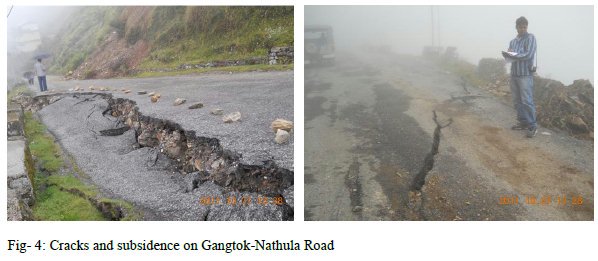
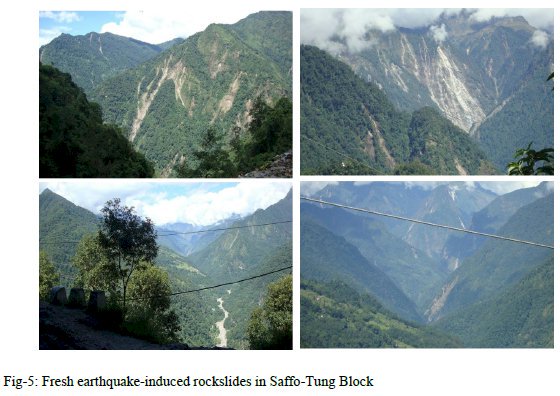
Field studies along 12 different road stretches of Darjeeling-Sikkim Himalayas revealed a total of 210 landslides proximal to the visited road sections (Fig. 1). This report does not contain the landslides that have occurred on natural catchment slope, which are inaccessible by road, for which detailed inventory mapping using pre- and post- event high-resolution satellite imageries would give additional information.
Amongst the 210 landslides, 195 are new and a few (15) are reactivated ones. The number of debris slides (114) (examples shown in Fig. 2) is slightly higher than rock slides (77) and rock fall (8) (examples shown in Fig. 3). There are 11 locations where major subsidence and cracks have also been noticed apart from landslides (Fig. 4). These earthquake induced landslides are mostly of shallow translational type having average depth of failure planes ranging between 2 m and 5 m. A detailed sector-wise landslide distribution and their attributes are enumerated in Table 1 and the respective locations of the observed landslides are plotted on a map (Fig. 1).
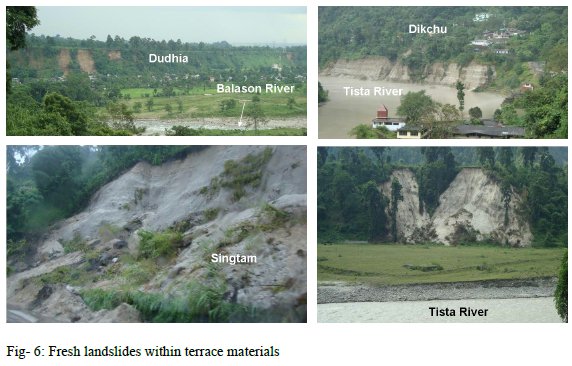
Discussion & Conclusions
Due to the 18 September 2011 earthquake, a large number of fresh landslides (mostly rockslides) were triggered in the steep and rocky Saffo-Tung mountain area of Sikkim, which is bounded towards south by the easterly flowing Talang Chu and towards east by the Tista, i.e. opposite to the Mangan-Singhik-Tung areas (Fig. 1). Preliminary field observation revealed that compared to this Saffo-Tung region, earthquake induced landslides and related slope instabilities are lesser along the left bank of Tista, which houses Mangan, Singhik, Manul, Tung etc. Even, compared to the Saffo-Tung region, the areas along the right bank of Talang Chu also have lower number of earthquake-induced landslides. Although this observation needs further ratification from mapping landslides (both pre- and post earthquake phases) of the entire region using temporal, high-resolution satellite imageries, which is likely to be taken up shortly. Another stark observation in the Saffo-Tung region is that a large number of earthquake induced rockslides occur proximal to the crest portions of its steep ridges and in its westward higher slopes (Fig. 5), which perhaps indicates the effect of the topographic amplification of earthquake induced ground motion in these steep rocky mountain faces 7 & 8. Moreover, it is worth mentioning here that the co-ordinates of the 18 September 2011 Sikkim Earthquake, according to the IMD/USGS estimates, also lies proximal (WNW of Saffo) to this Saffo-Tung mountain region (Fig. 1). The landslides that are located in the lower elevations within Lesser Himalayas are mostly concentrated within the terrace deposits (Fig. 6) of trunk streams such as Tista, Rangit and Balason etc. and also within the old colluvial deposits on adjacent to the banks of major rivers (e.g., Jorethang-Rishi-Legship section along the right bank of Rangit river) because of shaking of already-loosened and unconsolidated slope-forming mass.
Although, recent field observation revealed that the number of reactivated landslides is quite lower than the number of new landslides and most of the large debris slides in this region (e.g., Lanta Khola, Namok, 9 Mile landslides etc.) exhibit no activity due to the 18th September earthquake. Some minor reactivation is only observed in some old rockslides (e.g., Mayang Chu, B2, 13th and 17th Mile on Gangtok-Nathula Road etc.) where fresh rock falls due to the earthquake shaking are reported.
References
1. A preliminary report on the earthquake (M:6.8) of 18th September, 2011 in Sikkim-Nepal border region – browsed on 18/10/2011 --http://www.imd.gov.in/section/nhac/dynamic/eq.pdf
2. USGS report on Sikkim Earthquake of 18th September 2011 –http://earthquake.usgs.gov/earthquakes/recenteqsww/Quakes/usc0005wg6.php, browsed on 8/10/2011.
3. Searle, M.P., Szulc, A.G., 2005. Channel flow and ductile extrusion of the high Himalayan slab-the Kangchenjunga-Darjeeling profile, Sikkim Himalaya. Journal of Asian Earth Sciences 25, 173-185.
4. BIS, 2002. Criteria for earthquake resistant design of structures: General provisions and buildings, Bureau of Indian Standards (BIS) IS 1893:2002 (Part I).
5. Glossary in Seismology (IMD) - http://www.imd.gov.in/section/seismo/static/Glossary.pdf; browsed on 19/10/2011.
6. Seismotectonic Atlas of India and Its Environs. Geological Survey of India Publication (2000)
7. Sepulveda, S. A., Murphy, W., Jibson, R. W., Petley, D. N. 2005. Seismically induced rock slope failures resulting from topographic amplification of strong ground motions: The case of Pacoima canyon, California. Engineering Geology 80, 336-348.
8. Harp, E.L., Jibson, R.W., 2002. Anomalous concentrations of seismically triggered rock falls in Pacoima Canyon: are they caused by highly susceptible slopes or local amplification of seismic shaking? Bulletin of the Seismological Society of America 92 (8), 3180– 3189.
Article courtesy Geological Survey of India, Eastern Region, Kolkata
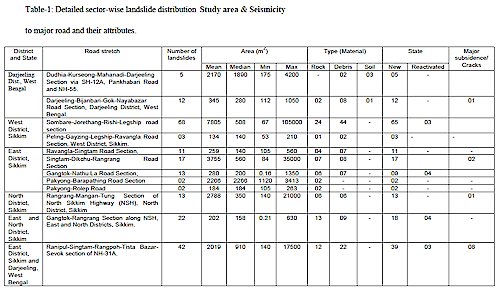
This report is help me in my Geography Practical project therefore i want more information about of it.
Its a good compilation. However, I have been working in Darjeeling area, can I have some proactive study material on Land slide protection? If any one can send some good material on Darjeeling Geomorphology also.
Thanks & regards,
Arindam